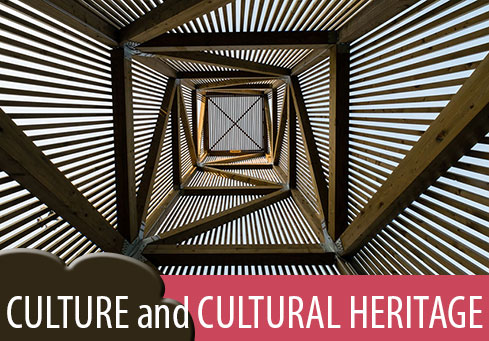Overcoming Development Challenges through Recommendations
Below is a list of the development challenges identified in Strategy 21.
Click on each challenge to find out more about the advised recommendations to enable policymakers, stakeholders and citizens to play their part in addressing these challenges.

Building a more inclusive and cohesive society
- S1 Encourage the involvement of citizens and local authorities in capitalising on their everyday heritage
- S2 Make heritage more accessible
- S3 Use heritage to assert and transmit the fundamental values of Europe and European society
- S5 Assess citizens’ participation practices and procedures
- S6 Create a suitable framework to enable local authorities and communities to take action to promote and manage their heritage
- S8 Encourage heritage rehabilitation initiatives by local communities and authorities
- S9 Support intergenerational and intercultural projects to promote heritage
- S10 Facilitate and encourage (public and private) partnerships in cultural heritage promotion and conservation projects
- D2 Support and promote the heritage sector as a means of creating jobs and business opportunities
- D3 Promote heritage skills and professionals
- D5 Encourage the reuse of heritage and the use of traditional knowledge and practice
- D6 Ensure that heritage is taken into account in development, spatial planning, environmental and energy policies
- D7 Give consideration to heritage in sustainable tourism development policies
- D10 Use cultural heritage as a means of giving the region a distinctive character and making it more attractive and better known
- D11 Develop new management models to ensure that heritage benefits from the economic spinoffs that it generates

Developing Europe’s prosperity by drawing on its heritage resources
- D1 Promote cultural heritage as a resource and facilitate financial investment
- D2 Support and promote the heritage sector as a means of creating jobs and business opportunities
- D4 Produce heritage impact studies for rehabilitation, construction, development and infrastructure projects
- D5 Encourage the reuse of heritage and the use of traditional knowledge and practice
- D6 Ensure that heritage is taken into account in development, spatial planning, environmental and energy policies
- D7 Give consideration to heritage in sustainable tourism development policies
- D8 Protect, restore and enhance heritage, making greater use of new technologies
- D10 Use cultural heritage as a means of giving the region a distinctive character and making it more attractive and better known
- D11 Develop new management models to ensure that heritage benefits from the economic spinoffs that it generates
- K6 Develop knowledge banks on local and traditional materials, techniques and know-how

Ensuring that Europeans enjoy a high quality of life, in harmony with their cultural and natural environment
- S1 Encourage the involvement of citizens and local authorities in capitalising on their everyday heritage
- S2 Make heritage more accessible
- S7 Develop and promote participatory heritage identification programmes
- S9 Support intergenerational and intercultural projects to promote heritage
- D1 Promote cultural heritage as a resource and facilitate financial investment
- D2 Support and promote the heritage sector as a means of creating jobs and business opportunities
- D3 Promote heritage skills and professionals
- D4 Produce heritage impact studies for rehabilitation, construction, development and infrastructure projects
- D5 Encourage the reuse of heritage and the use of traditional knowledge and practice
- D6 Ensure that heritage is taken into account in development, spatial planning, environmental and energy policies
- D7 Give consideration to heritage in sustainable tourism development policies
- D9 Use innovative techniques to present cultural heritage to the public, while preserving its integrity
- D10 Use cultural heritage as a means of giving the region a distinctive character and making it more attractive and better known
- D11 Develop new management models to ensure that heritage benefits from the economic spinoffs that it generates

Implementing the principle of integrated conservation
- S8 Encourage heritage rehabilitation initiatives by local communities and authorities
- D1 Promote cultural heritage as a resource and facilitate financial investment
- D4 Produce heritage impact studies for rehabilitation, construction, development and infrastructure projects
- D5 Encourage the reuse of heritage and the use of traditional knowledge and practice
- D6 Ensure that heritage is taken into account in development, spatial planning, environmental and energy policies
- D7 Give consideration to heritage in sustainable tourism development policies
- D8 Protect, restore and enhance heritage, making greater use of new technologies
- D9 Use innovative techniques to present cultural heritage to the public, while preserving its integrity
- D10 Use cultural heritage as a means of giving the region a distinctive character and making it more attractive and better known
- D11 Develop new management models to ensure that heritage benefits from the economic spinoffs that it generates

Ensuring that heritage is taken into account in sustainable spatial development strategies and programmes
- S10 Facilitate and encourage (public and private) partnerships in cultural heritage promotion and conservation projects
- D1 Promote cultural heritage as a resource and facilitate financial investment
- D2 Support and promote the heritage sector as a means of creating jobs and business opportunities
- D3 Promote heritage skills and professionals
- D4 Produce heritage impact studies for rehabilitation, construction, development and infrastructure projects
- D5 Encourage the reuse of heritage and the use of traditional knowledge and practice
- D6 Ensure that heritage is taken into account in development, spatial planning, environmental and energy policies
- D7 Give consideration to heritage in sustainable tourism development policies
- D9 Use innovative techniques to present cultural heritage to the public, while preserving its integrity
- D10 Use cultural heritage as a means of giving the region a distinctive character and making it more attractive and better known

Developing the ability of public services to address sustainable spatial development issues by means of better use of heritage
- D1 Promote cultural heritage as a resource and facilitate financial investment
- D4 Produce heritage impact studies for rehabilitation, construction, development and infrastructure projects
- D5 Encourage the reuse of heritage and the use of traditional knowledge and practice
- D6 Ensure that heritage is taken into account in development, spatial planning, environmental and energy policies
- D7 Give consideration to heritage in sustainable tourism development policies
- D8 Protect, restore and enhance heritage, making greater use of new technologies
- D10 Use cultural heritage as a means of giving the region a distinctive character and making it more attractive and better known
- D11 Develop new management models to ensure that heritage benefits from the economic spinoffs that it generates

Preserving and developing the ability of public services to address heritage issues
- S5 Assess citizens’ participation practices and procedures
- S6 Create a suitable framework to enable local authorities and communities to take action to promote and manage their heritage
- S10 Facilitate and encourage (public and private) partnerships in cultural heritage promotion and conservation projects
- D1 Promote cultural heritage as a resource and facilitate financial investment
- D2 Support and promote the heritage sector as a means of creating jobs and business opportunities
- D5 Encourage the reuse of heritage and the use of traditional knowledge and practice
- D6 Ensure that heritage is taken into account in development, spatial planning, environmental and energy policies
- K6 Develop knowledge banks on local and traditional materials, techniques and know-how




